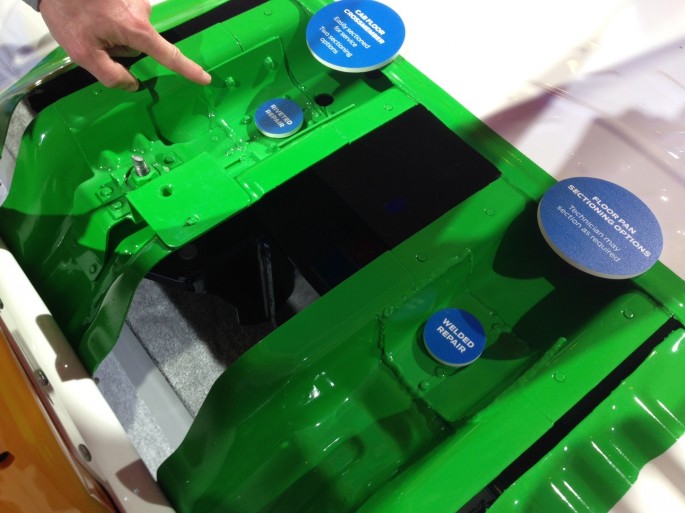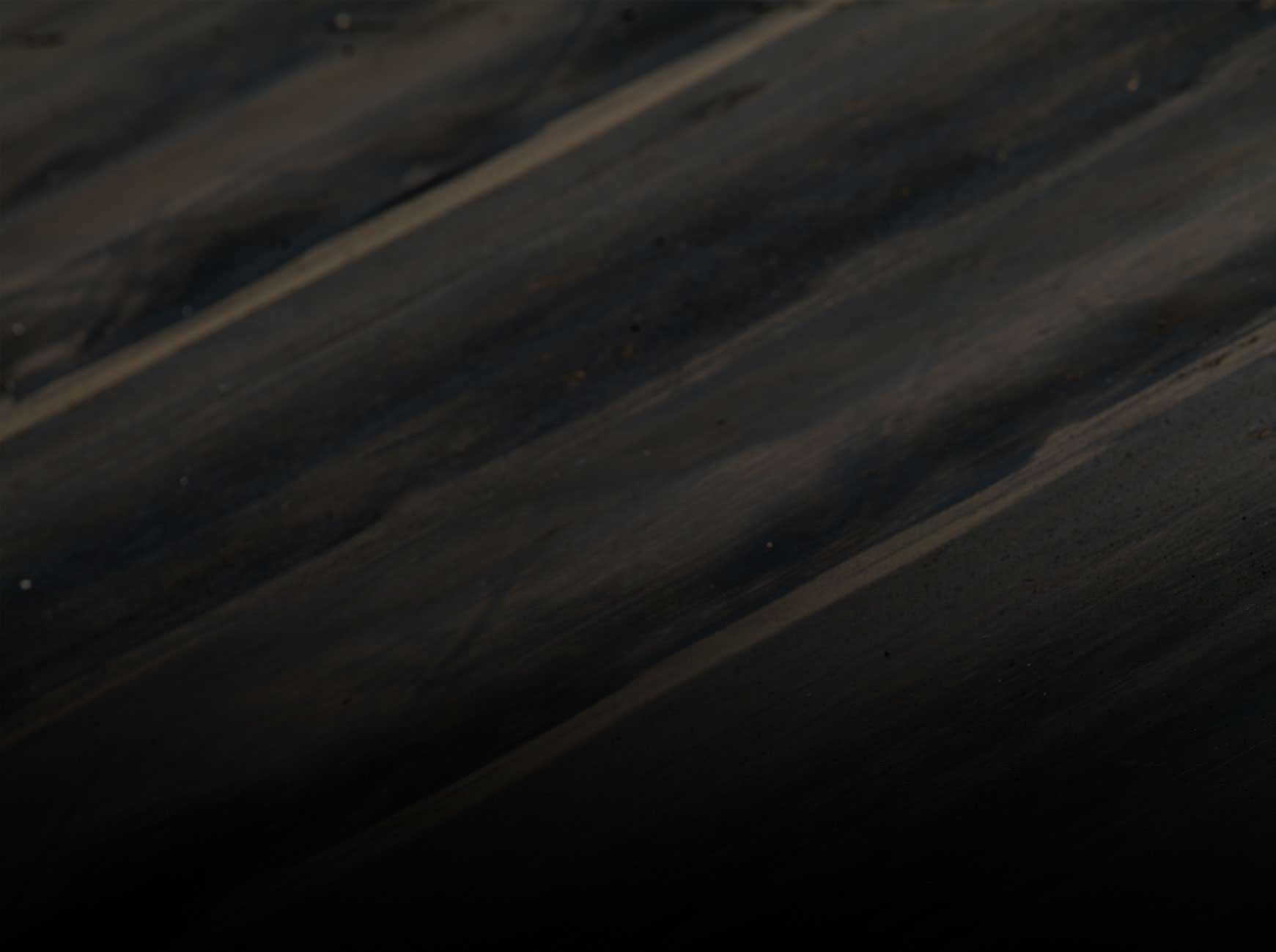(Words and photos by Craig Fitzgerald) – (Editor’s note: You may recognize the name Craig Fitzgerald. He worked on a bunch of the Hemmings magazines for several years and his byline has appeared all over the place. It is now going to regularly appear here at BangShift. Look for him to crank up on regular content next week. Enjoy this first dispatch from Craig’s experience at the NADA show in New Orleans!) –
The all-new 2015 Ford F150 has been making a lot of news with its heavy use of aluminum in the body structure. But since we first heard about it, we were curious how body shops were going to be able to repair collision damage. Sure, shops are repairing aluminum now, but typically in low volumes on high-end luxury cars, not on something as bread-and-butter as the F-Series. Turns out, it’s a lot like the way we repaired the blown-out rear quarters on the old Camaro back in the ’80s, with pop-rivets and liberal application of adhesive.

The structure of the F150 is built to be disassembled. Factory rivets in a damaged apron tube – the structure behind the front fender – are drilled out, and the piece comes off, replaced by a new apron tube that’s literally pop-riveted into place in the old rivet locations.

Even more impressively, body techs can replace the entire B-pillar using the same method: drill out the old rivets, pop-rivet the new one back in its place.

Smaller repairs outside of replaceable parts can be welded or riveted. Ford notes that it’s offering factory training for its 800 body shops at franchised dealers, as well as steep discounts on any equipment required to make the repairs. Since it will give Ford body shops a leg up on the independent competition on such a common vehicle, they’re jumping at the opportunity.
Ford showed the F150 repairs on a cutaway it had on display at the NADA show in New Orleans this week.


























Rosie the Riveter!
I’ve never seen “easy” translate to “less expensive”.
Pop rivets hold $40,000 aircraft together, they should work on a truck. But what about body panels? Are they going to be pop riveted too?
There are a lot more pop rivets on aircraft though…and quite a few are backed up by welding or heavy pins…
True, but they’re still pop rivets.
Solid rivets and not a few, welding aluminum weakens it by 50%
Aircraft are held together, but it’s not by “pop rivets”. There is a big difference in pop rivets and what will be in this truck. pop rivets will work loose under stress.
I don’t know of any aircraft running into each other at 25 miles an hour. I wonder how a repaired F150’s value will change once a car fax report exists. Plus Jaguar and Audi have had aluminum vehicles for a while now and those vehicles when damaged must be repaired at a specialty aluminum facility only. cannot use conventional body tools on aluminum.
There is no pop rivets on a aircraft. Pop rivets are weak and considered nonstructural. Solid rivets which are then bucked are used. If the back is inaccessible cherry-max rivets may be used. From a licensed AMT
rattle, rattle, rattle, rattle
Audi has a car that is all aluminum and it’s epoxied together. Can’t weld automotive aluminum. Car repair techs are going to be overwhelmed. No one to teach this technology. Aircraft industry bends aluminum, does not draw it into shape. Exceeding the yield point without braking it. That, is the difference between craftsmanship and blacksmith. Ford had been making aluminum hoods for 20 years. But, not without Alcoa and Budd co. showing them how.
Ford made an all aluminum unibody with the Jaguar XJ starting in 2004. I’m not sure it’s stressed skin but it is lighter and more structural than the refferenced D2 Audi A8/S8 platform.
Adhesives and rivets hold aircraft together and are very common for combat repairs on aircraft so I’m not scared of the proposed techniques to repair the new F150. If anything it’ll trickle down to other common cars so you’ll be able to get an aluminum bodied Camaro or Mustang (or if they do it right RWD Grand National/GNX) to offset the fuel economy penalty of a high Hp engine as CAFE gets tighter and tighter.
Just like my C-130’s! Now I want one! But I would wait a few years so they can figure out where the stress cracks are GOING to form…
Just like in the 80’s when we thought computers were going to kill performance. We all know how that went.
BMW has had this in the 5 and 6 series for years. Repair is not as hard as you think. Just need a second set of tools for aluminum since the steel will contaminate aluminum. Bonding and structural adhesive has held up in accidents after a repair. No worries, less weight, less corrosion, welcome to the future
Good post Sean. I got certified on the aluminum nosed 5 series at the South Carolina plant 10 years ago. They use very special rivets and other processes to ensure a quality repair. If used properly, the automotive epoxies are stronger than the materials they are bonding. This is not for the backstreet hackers.
Everybody talking airplane tech !
Airplanes fly through air !
Have you ever seen an airplane hit something solid even at low speed ?
Say good by to airplane ?
Oh yeh just put new panels in the old old holes ?
right they line right up and be correct.
New cars are planed to be disposable 🙁
Ford just says let it be a right off & insurance will let us sell an other one.
I want to know if the rivets are steel or aluminum? If they are steel will they rust out and body panels fall off? The blog doesn’t say anything about adhesive though I know it’s common in body panel repair. I would think Trucks are subject to more salt and metal-metal collisions than a typical aircraft. I to wonder about rattles and stress cracks.
Aluminum rivets… Steel would also cause dissimilar metal corrosion. ^^ and for all wondering aluminum is rarely welded on, because aluminum is soft it is necessary to make aluminum alloys which are then tempered to t3-t4 hardness. Welding would destroy the hardness around the entire welded area and would require panels to be heat treated again. .
Ford has been building all aluminum body “prototype” cars for real world testing for many years. I work for an aluminum company that supplies them and I can say they built some all aluminum Mercury Sables and our company got one to use and abuse in Canada for real world testing. Trust me, they would not risk their reputation on their best selling vehicle by using untested procedures.
Just like they wouldnt risk putting in poorly made tires or making a vehicle that is heavily prone to rolling and knowing about it?
http://www.autoblog.com/2010/04/26/ultra-rare-sho-powered-aluminum-bodied-mercury-sable-aiv-spotted/
A Ford pickup is a long friggin’ way from being an airplane.
Hey Craig,are you ever going to update your blog,Clunker Nation? I enjoyed Muscle Machines more when you were the editior. Did you ever finish your Riviera?
Don’t worry, we’re moving forward and things will change but we’ll figure it out.
Lighter cars and trucks will happen. Some day they’ll call ours “steel cars” like they call the “brass cars”.
In the meantime it might be good for the dealer bodyshops, it is all about the money.
Comparing aircraft vs automobiles is like the old apples vs oranges thing. Aircraft get huge amounts of stress pulling more “Gs” than cars while cars get huge stresses in crashes. Different strokes for different things.
That being said I had to laugh at the after a crash just drill out the rivets and replace the component line. Guess they have never seen parts pulled by the force of the crash. there is going to be a lot of pulling and pushing to get the new part to line up.
guys….think about how long aluminim boats have been in existance…there are few things that take more of a beating than the hull of a boat in rough water…they have always been riveted and welded both and absorb unbeliveable amounts of torque, especially in the transom…..
Bring one up here to northwest Pa. and we`ll see how long it lasts in the winter road salt!